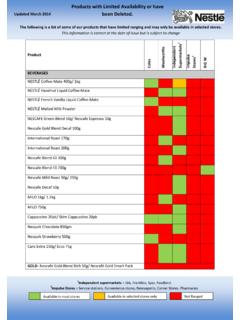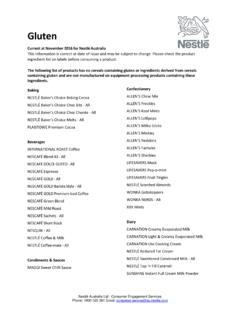Transcription of A Guide to Vegetable Gardens - Nestle
1 A Guide to Vegetable GardensThe Nestl Healthy Kids Global Programme aims to increase nutrition and health knowledge and to promote physical activity among school-age children around the Healthy Kids local programmes are implemented in many countries around the world. They are based on multi-stakeholder approaches, working with partners such as national and local governments, NGOs, nutrition health institutes and sport brochure has been produced by the Nestl Healthy Kids Global Programme for distribution to teachers and parents. It is a simple and useful Guide that explains how everyone can grow their own vegetables, whether small-scale, for home or classroom observation purposes, or large-scale, to help feed a local original version of this booklet was developed by Nestl Ecuador: the Healthy Kids programme in Ecuador was the first to promote gardening as a means for encouraging Vegetable and fruit consumption while developing environmental awareness.
2 This programme offers workshops on organic gardening and how to implement them in educational centres. The Nestl Healthy Kids Programme: Promoting nutrition education and physical activity1. Introduction Why grow your own vegetables? The benefits of a Vegetable garden 72. Where can you plant a Vegetable garden ? Who can help? 8 What you need to build a Vegetable garden Tools and basic equipment Seeds Good soil 143. The importance of fertilizer Organic fertilizer Compost How to make compost 194. Step-by-step Guide to making a Vegetable garden How to make a Vegetable garden Making a grow box Preparing the soil Filling the grow boxes 25 Contents45. Planting your Vegetable garden Sowing seeds directly into the ground Sowing indirectly into seedbeds Seedbeds Planting the seeds How to transplant seedlings 326.
3 Looking after your Vegetable garden How to care for your garden How to improve soil 367. Using water wisely Watering and saving water Simple tricks for saving water in your garden Dangers of contaminated water 418. Dealing with pests and diseases naturally 42 Preventing diseases 429. Harvest time How to plant, sow and harvest at the right time 44 Nowadays, families strive to prepare balanced menus, based on nutritious ingredients. A Vegetable garden is a simple and sustainable way to improve your quality of radishes or a tasty fresh lettuce that is the product of your own labour: these are very real examples of how we can improve the nutrition and physical well-being of families and Introduction Why grow your own vegetables?6 Better quality, more nutritious food All the fruit and vegetables grown in your garden are easily grown by yourself.
4 It does not require specific skills and is relatively Using organic waste matter as fertilizer, we can reduce landfill waste, thereby reducing Vegetable garden has other benefits too A shared space and activity that encourages both children and adults to spend time outdoors. A Vegetable garden can increase children s Vegetable consumption and willingness to try new vegetables they have grown. A place to learn, an opportunity to work the land and learn about our local environment. A garden can teach us to love Nature, create an interest in conservation and encourage us to respect The benefits of a Vegetable gardenLarge Vegetable Gardens are much more successful when the community is involved and motivated. Getting people involved right from the start in planning and discussing the garden is an excellent idea.
5 This will build commitment, spread the workload, help you avoid mistakes and stimulate interest in the school or the community s activities. Parents and volunteers can help with garden work. Parents can help with children s gardening tasks and homework. They can visit the garden and participate in talks, demonstrations, food fairs and addition, local partners, company volunteers and local communities can be involved and provide their time, expert advice/collaboration, help, supplies, equipment, Where can you plant a Vegetable garden ? Who can help?8 All an organic Vegetable garden needs is a little soil: it doesn t need to be big. In this Guide , we recommend using grow boxes or plant pots. You might start out with just four lettuces in a plant pot, or some leafy tomato plants in a large window box, but the experience is always magical and satisfying.
6 Every plant, every living thing, opens a door into a world of discovery and learning. All we have to do is watch and care about what we are Where can you plant a Vegetable garden ? What you need to build a Vegetable Tools and basic equipmentTrowel Handy for moving seedlings to the ideal for making drills for the plants. Cuts without Hoes are used for weeding and gardening. The steel blade sinks into the earth to remove weeds and stir the soil, thus giving keeper plants more moisture, nutrients, and growing Secateurs should fit your hand comfortably. Use them to make clean, accurate the tools are best used by adults. Should children need to use them, ensure adult supervision at all times!Hand fork Good for weeding around the plants and aerating the soil. Ideal for turning the can Use a watering can if you have one or simply punch a few holes in a plastic bottle Use for spraying plants, getting rid of dust and treating Where can you plant a Vegetable garden ?
7 Tools and basic equipment12 The best way to grow healthy plants is to keep your own seeds or buy them from certified organic shops. The seed is the part of the plant that we sow in our garden . Good seeds are clean, germinate quickly and are resistant to pests or SeedsThe soil is the starting point for every food chain and the top priority for organic gardeners. Good soil is essential if you want plants that: grow well Are resistant to disease and pests Are nutritious2. Where can you plant a Vegetable garden ? Good soil14 Plants feed on substances found in the soil, but over time the floor nutrients in the soil are depleted, and we need to use fertilizer to replace them. Organic fertilizer is a natural product obtained from the decomposition of plant and animal matter. Organic fertilizer can make the soil more fertile.
8 There are a number of different organic fertilizers, including compost, vermicast (worm humus), and The importance of Organic fertilizer163. The importance of CompostCompost is made by allowing food leftovers and garden waste to decompose. It is also known as compound fertilizer. Organic plant matter: weeds, plant waste (hay, pods, fruit, fallen leaves, old plants, etc.), sawdust, wood shavings. Domestic waste: biodegradable products(all kitchen waste other than plastic, tins, glass and other non-biodegradable products). Plant ash, lime, earth, fatty foods like meat and dairy products, and large chunks of wood, plastic, metal, glass, wire and other materials that are not to doThere are different ways of making compost: on the ground, in a container, or in a pit dug in the you are using a container, it is best to pierce a few small holes to allow water to drain.
9 Whichever method you choose, you will need to follow these instructions:1. Choose a shady spot that is easily Flatten and level the ground and aerate by turning the soil over. If you are using a container, puncture the sides to allow air to circulate. It is also best to mount the container on bricks to raise it above the ground and make it easier to remove the compost when How to make compost3. The importance of How to make compostWhat to do3. Layer the waste matter for composting: The bottom layer (drainage layer) should be about 2 cm deep and contain dry matter like leaves, hay and dry stalks. A 20 cm layer of plant matter: kitchen and garden waste. A 5 cm layer of manure or other animal fertilizer. If you do not have any manure, you can use lime or ash. Finally, 2 cm of soil or mature compost.
10 You will need to water the compost heap as you work: water speeds up the fermentation process. Keep on adding layers in this order until your container is full. The compost heap should be about one metre high. Don t forget to keep When you have added the last layer, cover with straw, dry grass or a damp cloth to keep the heat and moisture in. Water one last t forget Keep your compost heap moist. Turn the heap once a fortnight to make sure everything decomposes at the same speed. It takes 90 days to several months tomake organic compost, depending onthe temperature and compost should be dark brown, with a soft, crumbly texture and pleasant earthy How to make compostYou can create your own Vegetable garden bysowing seeds in grow boxes made of wood, brick or breeze blocks. You can also sow your seeds in any other unused clean and appropriate sure you put the containers somewhere that gets sunlight during most of the day and is close to a water Step-by-step Guide to making a Vegetable How to make a Vegetable garden22 What you need Wood Nails Wooden batonsWhat to doMake your grow boxes using wood.








